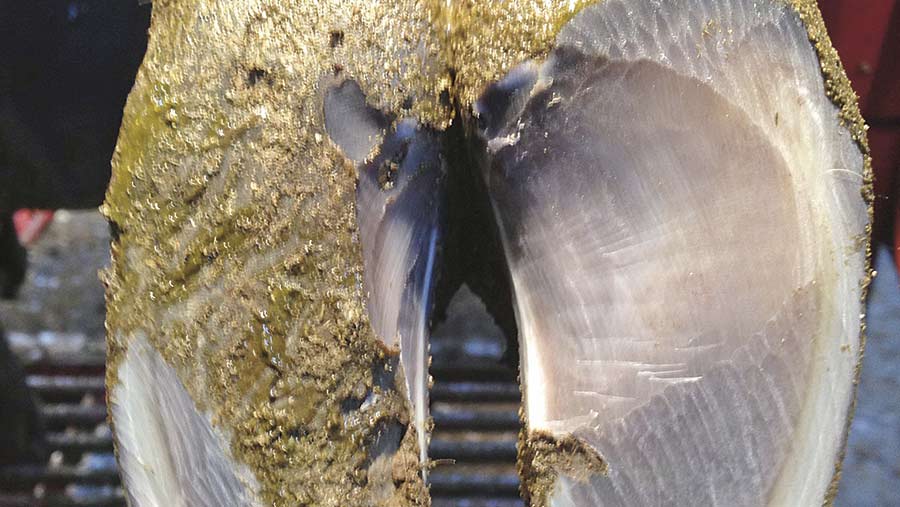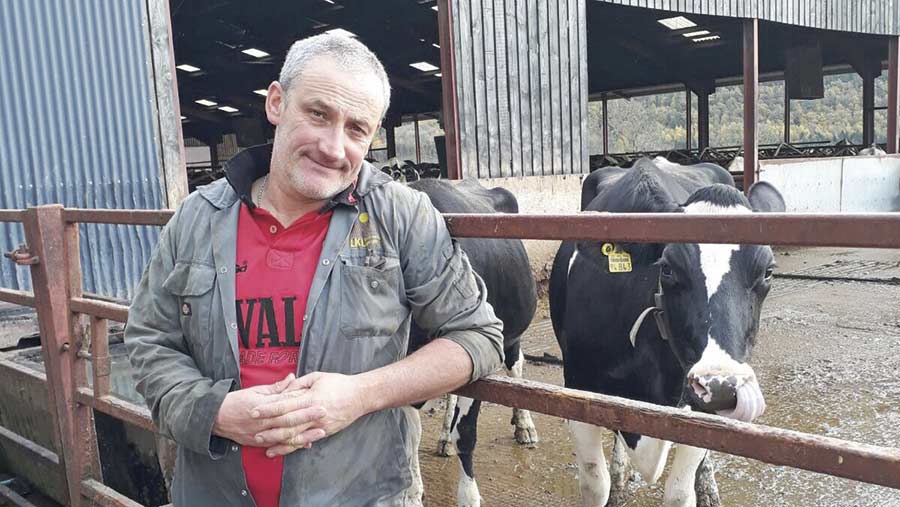How to help prevent lameness with foot trimming technique

Farmers and trimmers could afford to be bolder when it comes to modelling out the sole of the foot and, in doing so, reduce the chance of cows developing lesions, such as sole haemorrhaging, sole ulcers and white line.
Modelling is a vital part of any functional trimming strategy. By modelling or “dishing out” the centre of the sole of the foot, the pressure is taken off this area – which is the typical sole ulcer site – and transferred to the harder and stronger walls of the foot.
What does a “bigger scoop” mean?
Typically, as part of step 3 in the Five Step method of trimming, a “scoop” of less than two-thirds of the lateral (outside) claw is taken and around a third on the medial (inside) claw on the back feet.
The back, outside claws form the focus because they take the majority of the cow’s weight and consequently 95% of all lameness occurs here.
However, some consultants and trimmers are suggesting that some people are not modelling enough and there could be room to increase the size of the scoop over these guidelines.
Kite Consulting’s Sam Evans says he has completed lameness audits on many farms where modelling is not carried out sufficiently.
See also: Top 10 tips to help avoid cow lameness in winter months
He explains: “Typically, people don’t follow the full five steps of the Five Step method and specifically the modelling. And if farmers haven’t been on an up-to-date foot trimming training session, they tend to model out very slightly.”
As a result, such farms struggle to truly get on top of lameness because too much horn is left on the foot, leading to increased pressure on the sole ulcer site and, potentially, higher lameness rates.
Modelling guidelines
- Follow all steps of whichever foot trimming strategy you are using
- Use a sharp knife to achieve the appropriate scoop so that thin layers can be shaved off
- Model out two-thirds of the lateral (outside) hind claw
- Model out one-third of the medial (inside) hind claw
- Adjust depth of scoop in-line with individual cow foot structure
- Stop going any deeper as soon as the sole “gives” under thumb pressure
In fact, addressing modelling depth and width (see box, right), has proved to be a key part of successful lameness control strategies on a number of Mr Evans clients’ farms. He says most farmers have been surprised by how much you can dish out.
“For most of them, no one has shown them or given them the understanding of the mechanics of the foot and the fact you don’t want weight on the area you’re scooping out because that’s where the sole ulcer risk is,” says Mr Evans.
Taking a deeper and wider scoop essentially “buys time” because there is a longer growing period for the horn to come back, so the period of risk for sole ulcers is reduced.
A foot trimmer’s perspective
A number of foot trimmers are now modelling out to a greater extent and take more than two-thirds on the lateral hind claws.
Foot trimmer David Rowe uses this adapted approach and says the benefits he has seen highlight the importance of wider and deeper modelling.
“Since moving to the wider and deeper model on all of my clients herds, I have noticed a significant reduction in sole haemorrhaging, sole ulcers and white line incidences,” he says.
He references a Cheshire farm where increasing the modelling depth and width resulted in sole ulcer incidence reducing from 6.6% of lame cows to 0.9%. Sole haemorrhages also fell from 80.7% of lame cows to 7.6% over a two-year period.
Mr Rowe emphasises that the modelling depth is just as important as the width and says the model should be stopped when the sole flexes under thumb pressure but is not too soft.
Research evidence
Mr Evans says there is increasing evidence that greater modelling is beneficial.
He cites an ongoing study by Gerard Cramer of Minnesota University, which is comparing modelling depth. To date, first lactation animals that were trimmed with a bigger model (18mm from the outer foot wall) at drying off had less horn lesions in the next lactation.
These cows also stayed non-lame for a longer period than those that only had a shallow model.
Mr Evans underlines the need for farmers to incorporate planned, routine trimming as part of their overall farm strategy. He recommends cows have their feet picked up a minimum of twice a year – at drying off and 100 days in milk.
Good records and making sure cows are actually seen at these times are key to success.
Adequate modelling at drying off is particularly important, due to the fact the hormones produced at calving cause the tendons around the pedal bone to relax. Increased pressure from the pedal bone on the sole of the foot can consequently lead to increased risk of ulcers later in lactation, particularly if cow environment is not adequate.
Case study: Gareth Williams – EM Evans, Priddbwll Mawr, LIangedwyn, Oswestry

Herdsman Gareth Williams believes increased foot modelling has been one of the main reasons for a 60% reduction in sole ulcers in first lactation heifers and a marked improvement in overall lameness in the 600-cow herd at Priddbwll Mawr.
Two years ago, the farm was struggling with sole ulcer incidence, especially in first lactation heifers.
This was subsequently compromising performance and leading to animals not lasting in the herd, which yields 11,500 litres a cow a year at 3.79% fat and 3.29% protein.
As a result, he attended a foot trimming training day with Kite and trimmers Karl Burgi and David Rowe, where he learnt about functional trimming and the size of modelling required.
The extent of modelling was an area that surprised him, but immediately made sense once the structure and pressure points of the foot were explained.
He says: “Before, I modelled out the size of a teaspoon. Now I’d model out the size of a dessert spoon. Karl Burgi talks about the size of half an egg. I take one teaspoon on the inside claw and the rest on the outside.”
All animals are now trimmed using this method. This includes in-calf heifers before calving. Milking cows are also trimmed at drying off and 100 days in milk (DIM). They are also inspected and trimmed if necessary at 250 DIM.
Other improvements have been made in lameness management, including better recording, carrying out routine trimming on time and reducing turning points in the sheds.
Mr Williams believes the heifer trim has made a substantial difference. The modelling aspect in particular has proved vital, considering the high level of horn growth seen in these housed, growing animals.
The 60% reduction in sole ulcers in heifers means levels in the milking herd have also subsequently reduced.
“I like to believe we’re getting the angle of the heifer’s foot right before they come into the herd so they don’t have the pressure on the sole ulcer site,” he says.
